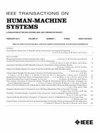Real-Time Posture Identification System for Wheelchair Users Preventing the Generation of Pressure Ulcers
IF 4.4
3区 计算机科学
Q2 COMPUTER SCIENCE, ARTIFICIAL INTELLIGENCE
引用次数: 0
Abstract
Prevention is key to avoid pressure ulcer generation in people with mobility restrictions. In recent years, preventive medicine has focused on posture control by considering people who frequently have the same position for too long, such as wheelchair users. Optical fiber sensors have gained recognition for their applications in biomedical engineering; however, approaches to assistive devices, such as wheelchairs, have been relatively unexplored. This study proposes a polymeric-optical-fiber (POF) sensing system based on machine learning (ML) for human posture recognition in an electrical wheelchair-based human machine interface (HMI). The ML-based model was used to classify time- and frequency-domain features obtained from a matrix of POF-based pressure sensors and 24 photodetectors during the execution of eight body postures. In an offline stage, multiclassification was conducted using k-nearest neighbors (KNN), decision tree, extra tree classifier (ETC), and random forest, where the best performance, in terms of accuracy (ACC), was obtained through the use of ETC (94%). Hence, this classifier was implemented in real-time, where the wheelchair-based HMI achieved a CPU time of approximately 117 ms, and an ACC higher than 96%, outperforming the metrics previously reported in the literature. We believe that this study contributes to the development of smart assistive systems that integrate ML and soft sensors to recognize body postures in an HMI, which is a promising approach for preventing the generation of pressure ulcers in wheelchair users.用于轮椅使用者的实时姿势识别系统,防止产生压疮
预防是避免行动不便者产生压疮的关键。近年来,预防医学将重点放在姿势控制上,考虑到那些经常长时间保持同一姿势的人,如轮椅使用者。光纤传感器因其在生物医学工程中的应用而获得认可;然而,用于辅助设备(如轮椅)的方法却相对较少。本研究提出了一种基于机器学习(ML)的聚合光纤(POF)传感系统,用于识别电动轮椅人机界面(HMI)中的人体姿势。基于 ML 的模型被用于对从基于 POF 的压力传感器矩阵和 24 个光电探测器获得的时域和频域特征进行分类,这些特征是在八个身体姿势的执行过程中获得的。在离线阶段,使用 k-近邻(KNN)、决策树、额外树分类器(ETC)和随机森林进行了多重分类,其中使用 ETC 的准确率(ACC)最高(94%)。因此,该分类器是实时实现的,基于轮椅的人机界面的 CPU 时间约为 117 毫秒,ACC 高于 96%,优于以前文献中报告的指标。我们相信,这项研究有助于开发智能辅助系统,该系统集成了人工智能和软传感器,可识别人机界面中的身体姿势,是防止轮椅使用者产生压疮的一种有前途的方法。
本文章由计算机程序翻译,如有差异,请以英文原文为准。
求助全文
约1分钟内获得全文
求助全文
来源期刊

IEEE Transactions on Human-Machine Systems
COMPUTER SCIENCE, ARTIFICIAL INTELLIGENCE-COMPUTER SCIENCE, CYBERNETICS
CiteScore
7.10
自引率
11.10%
发文量
136
期刊介绍:
The scope of the IEEE Transactions on Human-Machine Systems includes the fields of human machine systems. It covers human systems and human organizational interactions including cognitive ergonomics, system test and evaluation, and human information processing concerns in systems and organizations.
 求助内容:
求助内容: 应助结果提醒方式:
应助结果提醒方式:


